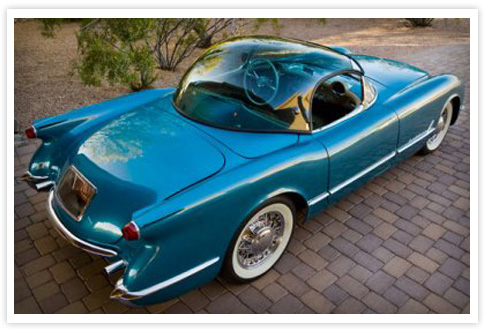Bubbletop Cars: Futuristic cars from the past
Aircraft and spacecraft have influenced automobile design since the debut of the Flash Gordon serials in 1936. After WWII, designers incorporated jet fighter styling into the automobiles of tomorrow. Bubbletops, similar to those covering cockpits of fighter jets and spaceships, were used on concept, custom, and production cars from major manufacturers to customizers such as Darryl Starbird. Check out this list of some of history’s most iconic, collector favorites.
1954-55 Chevrolet Corvette “Bubbletop” Roadster
Chevrolet released the Corvette on June 30th 1953, with a controlled launch of 300 cars. But the debut was, by all accounts, a flop. The socially-elite drivers targeted by Chevrolet’s marketing team questioned the Corvette’s quality and performance and gave the new car lackluster reviews.
In 1954, assembly moved to St. Louis, Missouri, and production increased to 3,640 cars. Chevrolet began to address the Corvette’s weaknesses; a change to the camshaft of the Blue Flame Six resulted in a 5-horsepower boost and three new exterior colors (red, black and blue) were offered. Even with the improvements, sales were soft, leaving more than 1,100 cars unsold at year’s end.
Auxiliary hardtops were not a factory or factory-sponsored dealer option for 1953-55 Corvettes, but aftermarket shops, such as Plasticon and Scottop, stepped in to fill the void. Eugene Kettering, Chief Engineer of GM’s Electro-Motive Division and owner of an early ’54 Corvette, was not pleased with the limited visibility and lack of headroom with the top raised. After receiving approval from GM Styling Chief Harley Earl, Kettering approached William Chaffee of Model Builders Inc. to solve the problem.
A Chicago based engineering firm specializing in high quality architectural, process, and product models, Model Builders was amply qualified for the task and delivered was a futuristic, acrylic plastic (fiberglass) bubbletop, reminiscent of GM’s Motorama concept cars. While visually stunning, the airflow and water sealing abilities were less than desirable. The high cost ($500 on top of the Corvette’s $3,000 price tag) and quality issues led to low demand. Approximately 25 bubbletop Corvettes were produced.
1955 Lincoln Futura
The Lincoln Futura is quite possibly the most iconic bubbletop car of all time. William Schmidt, Manager of Lincoln’s Styling Department, drew inspiration from the sleek, smooth lines of the manta ray, mako shark, and jet aircraft. The result was an eye-catching design that would prove to be Lincoln’s most successful concept car.
Italian coachbuilder Ghia submitted the winning bid of $250,000 to build the Futura. Lincoln provided all of the necessary blueprints, plans, and components and Ghia delivered a handcrafted masterpiece.
The Futura featured fiberglass twin-canopy domes covering the cockpit, hooded (almost hidden) headlights, and front and rear tailfins that would become a staple of 1950s automotive style. Power was derived from a 368-ci V-8, putting out 330 horsepower.
By 1959, the Futura’s popularity as a show car began to fade. It was sold to George Barris, the self-proclaimed “King of the Kustomizers.” Retirement was short lived as the Futura appeared in the movie It Started with A Kiss, starring Debbie Reynolds and Glenn Ford. After its flirtation with film, the Futura sat parked behind Barris’ shop until 1965.
Twentieth Century Fox commissioned Barris to design and build a Batmobile for the upcoming television series starring Adam West. After efforts to customize a 1959 Cadillac failed, Barris turned his attention to the Futura. He hired Bill Cushenberry, a fellow customizer from North Hollywood, to perform the metal work that would transform the Futura into the Batmobile and an icon was born.
The Batman television series was a hit and the Batmobile was arguably its biggest star. Barris built four Batmobile replicas for the show using a variety of donor chassis.
In 1990, Bob Butts was authorized to build replicas of the Batmobile and created a true-to-spec replica of the Futura. It is the only Futura replica known to exist. The Futura Batmobile is still an attraction and now resides at Barris Kustom Industries in North Hollywood, California.
1955 Lancia Aurelia “Nardi” Blue Ray
Italian artists have created some of the world’s most historically significant paintings and sculptors. The tradition has carried over to the automotive world, as cars designed by Bertone, Pininfarina, Scaglietti, and Zagato (just to name a few) are widely regarded as some of the most beautiful ever created.
Enrico Nardi owned a shop in Turin that built parts and, occasionally, entire cars for marques such as Alfa Romeo, Fiat, and Lancia. The 1955 Lancia Aurelia Blue Ray I is widely regarded as Nardi’s finest work.
Lancia wanted a show car that would make people swoon. Nardi had an exceptional relationship with the automaker, most notably from the work performed on a Formula 2 project. Coachwork for the show car would be designed by Michelotti and constructed by Vignalle. Nardi fitted the coachwork to a tubular steel Pan Amercian chassis. Lancia provided a B20 V-6 engine, which Nardi tuned to produce 190 BHP at 5,500 RPM.
The Blue Ray’s bubbletop roof is made of blue Perspex and is outfitted with a grilled air scoop and internal directional vents. The side windows open up toward the roof, similar to the doors of a gullwing.
The name Blue Ray (Raggio Azzurro) is derived from the two-tone color scheme. Just as the Lancia Aurelia B10 before it, the “Nardi” Blue Ray met the public at the 1955 Turin Motorshow. Blue Ray I survives to this day. It was last (known) restored in 1989 and shown at the Pebble Beach Concour d’Elegance that same year.
Think you know your bubble tops? Check out this month’s “Name That Top” challenge for your chance to win a free gift from the Historic Vehicle Association.


